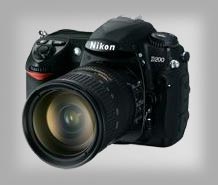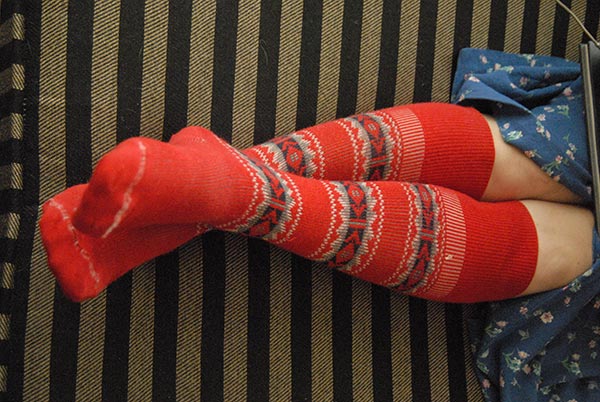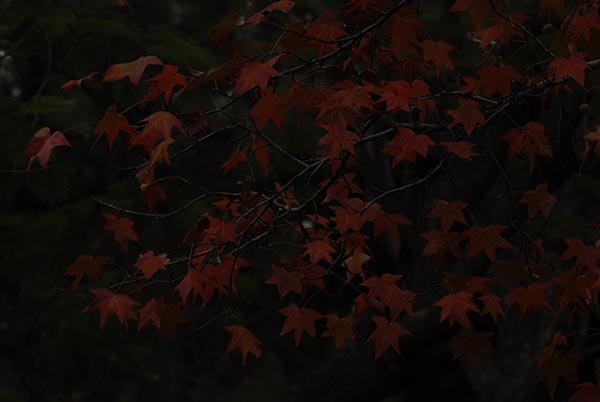
| Home |
When you pick it up, a promise is conveyed.
Everybody's first impressions will be unique. But one thing is for sure. Your first impression with the D200 in hand will be strong, positive and memorable. This is a destination of a camera. It's an instrument you travel to. And when you get there, you know that the experience is just beginning. Functions are logical to a fault. If a hidden function is associated with a button or switch, its eventual logic soon becomes apparent. Most of the exterior is wrapped in no-slip rubbery polymer over the all metal frame. It's not a lightweight camera at 830grams (1 lb, 13 oz and 38% heavier than the D70), but it has a professional heft and inertia that works well with VR lenses to buy you longer shutter speeds. I easily gather an available light shot with a 1/13 sec exposure while zoomed to 102mm. At ISO 3200 grain is obvious. But not on a 4 x 6 print. The file has too many pixels to show up as grain at that size. You'll see the grain of high speed images at 8 x 10, but only if you know to look for it. At ISO 100, images are supremely grain free and chillingly color accurate. You tell me: What ISO snapped up those socks? Open the image in a new window and the name of the file will give it away. > Of course the Big Spec that everybody hears is the Megapixel count. D200 images have 3872 x 2592 pixel images for a true 10MP image of 10,036,224 tiny dots of picture. The chip itself has 10.92MP of photosites and some of those aren't playing ball. They're sitting on the sidelines under a mask reporting to the computer things like, "This is what black looks like under current thermal conditions," and stuff like that. > Almost nobody is jumping up and down with the next Hot Flash, but they ought to: The Medium frame from the D200 is 2896 x 1944 pixels big. That's 96% of the size of the D70's Large frame. In other words, the D200 Medium frame is a PERFECT D70 (6MP) frame after the downsampling. The D200 got a new battery. Just what I need. A new battery. This one is the EN-EL3e and charges in the new MH-18a Quick Charger. These new batteries have a portion of the case cut a tad deeper allowing them to insert into the D200. But prior EN-EL3s you may already own don't have that cut out, and they won't insert into the camera's battery bay. Nor do the older batteries hold as much energy (1400 MAh vs. 1500 MAh on the new ones--whoopie!) but the real difference is the three contacts on the EL3es where the EL3s had only two. There's more inside the 3e than just more juice. A circuit tells the camera how much more power is left, so the camera tells you more accurately how close to finished you are with the current battery charge. At least, that's the idea. The battery charge indicator has five segments in the camera-top LCD display and a menu page tells you what actual percent of charge still remains. > The new EL3e's are smarter than those in other brands. Sony has its "InfoLithium" batteries that report pretty accurate time left under current conditions and those are fine for the various Sony products I use, but these 3e's go one better. As the camera monitors their charge flow, it's also doing an analysis of how the state of the battery is performing according to standards exhibited by batteries over their full life. > What that means in English is that the camera can then tell you not just how much juice is left, but how run-down the battery is in terms of its useful life. A detailed menu page lets you know remaining charge as a percentage, how many times the shutter has cycled since the last full charge and where the battery is in terms of its overall service life on a scale of New and 1 through 4 (get a replacement). One of the smarter things a camera manufacturer could do to assure their own batteries--and not some third-party source--were being used is to embed the battery with vital circuits that completed the power system functions. Am I going to buy Nikon Brand EL3es? Why risk upsetting the power system?
Why the D200 feels good. Rollover for 100% chunk. > Legacy lens use. It rather irked me that Nikon's older, mechanical aperture lenses could tell my F3 what its iris was set to, but not my D70. Putting that old lens on the D70 forced an all Manual focus and exposure system with no help from the camera. The camera couldn't even tell me what the meter was thinking. All that has gone away. The D200 works with prior AF Nikkors with full auto focus powered by a mechanical link inside the camera body and even with AI lenses that transmitted the current f-stop setting to the camera by engaging a tab on the lens mount work well. I was even able to shoot manually with an old f/2 135mm in no light. A lens that harkens back to the 70s. > On board menu help. Designers know that the camera is really a computer with a lens. Now they've taken a logical next step into the menus as an operating system with on-board help files. Get lost? If the menu item that seems logical to get you out of the current impasse has a question mark somewhere on its page, hit the Lock/? button and here's your help file. Help pages aren't there for literally everything, but 97% of the menu items have a page or two of built-in instruction.
> Deep JPEG images. When you want the ultimate out of an image you can use the RAW or Compressed RAW file formats to store your shots. Compressed RAW takes around 59% of the space a virgin RAW file consumes, and I'll be surprised if anybody comes up with a definitive display of how to tell the two apart once interpreted, but the D200 JPEG images hold a lot that you don't see, but can recover in Photoshop. We've been shoving images around with the D70's iNovaFX Photoshop Actions and results have been exceptionally good. It's not unreasonable to pull good results out of a D200 JPEG that was underexposed three stops (Intentionally--I swear! Yeah, right.) and pull its tonalities up into reasonable. The D200 iNovaFX Actions haven't been written, yet, but when they are, they'll be tweaked to make the corrected image look as close as possible to the tonalities and color of a perfect exposure. > Somewhere in the far flung past somebody realized that having a light inside your refrigerator was a good idea. If they had required you to snap a separate switch to activate the light, you would have sent the fridge back to Sears with an angry note. Odd, don't you think, that it has taken until now to apply that 1937 Frigidaire thinking to a digital camera? But once the idea is out of the bag, it's going to be nearly impossible to convince other manufacturers not to copy Nikon. > Here's what we mean: With the D200, pressing ANY button that has anything at all to do with altering an idea that is tracked on the camera-top LCD data display, does the logical thing: it turns the backlight ON. > B'b'b'but what if you are in broad daylight? The light comes on. So what. It's an LED. It draws a gnats worth of power. If you need to quench the light, a menu item, Illumination, turns it off. > What's it worth? After shooting more types of images with it and pushing it farther this way and that, the question of value is unavoidable. If you say the body of a D70s is a $900 idea, then what would the D200 be in terms of upgrade over that?
> According to my calculator, all these modifications have more than doubled the cost of my D70 (total with all the hot modifications: $2,200), but it has turned out to be one heck of a D70! But for $500 less than that, the whole thing comes integrated into an all-metal frame with a glass pentaprism viewfinder, six more auto focus points and four extra megapixels of image are thrown in free. > I was showing the camera to a designer friend this afternoon and he noted that there's so much new, improved, re-thought, revisited, re-designed and reconsidered in this camera versus the D70 that there's no way a person can go into a camera store and touch the camera at the counter for a half-hour and really 'get it'. (Months' later note: He borrowed mine several times, saved up his quarters, then bought one, and has been singing its praises ever since.) If you know somebody who has already gotten one, ask them to show it to you and discuss it with them for a while. There's not much in this camera you won't like, but it's possible that the D200 is more than you need. The current D70s makes delicious tabloid size prints and the cost is $800 fewer dollars. (Months' later note: Or, how about that D40? Same 6MP image as the D70, but much easier on the eye --- and wallet.) A quick look through the camera: a quick visit to the LA Auto Show Gallery. The more I shoot with this, the better it feels. Some owners have reported problems--I guess this is inevitable with all high tech new products--but the camera in my hands (SN: 3002xxx) has exhibited zero defects. Perhaps this suggests that you should buy your D200 from a local live human dealer, just in case your D200 reveals an "issue" and will need to be immediately swapped for a better working sample. I did. In the past this has saved my bacon. Is there going to be a DSLR: Nikon D200 eBook? Yes. We're thinking Spring 2006. (Late note: Can you believe it, that eBook took until August to write. This camera turned out to be much deeper than originally estimated.) Work is already underway (mid January, 2006) and we have been enjoying the process of pushing every feature, button and switch to the limit and beyond. The eBook will get into the D200s deeply intimate relationship with the SB-800, too. It's another wow. (Late note: It definitely has a Wow factor, and the camera has spawned its share of new improved iNovaFX Photoshop Actions.) Physically and ergonomically, the D200 camera is an inspiration. Over time we will get to know it and learn its secrets. The DSLR: D200 eBook will be the deepest yet. So far, that has proven to be the case. First quibble: The Instruction Manual. It's the biggest and most complex manual we've seen from Nikon and it looks like it took a lot of work to make it, and all the information about every button and menu item is buried in there, but it still suffers from a major case of manualitis, the disease many instruction manuals suffer from at birth. If doctors studied the human body only from manuals, we'd all be dead. Manuals tend to describe function. Photographers need to know what each button and option does, all right, but they also need to know when to use what and why. One place the Manual immediately falls flat is in the Index. Numerous times the Index intercepts your search topic and sends you somewhere else. That's a Good Thing, but it fails too often to be a wise thing. Quote: "Time exposures. See Long time-exposures" When you flip the page, find the Ls and locate the entry five seconds later you get "Long time-exposures, 68, 131" Why they couldn't simply have entered this in the Ts is beyond me: "Time exposures, 68, 131" Just because they wrote it down somewhere doesn't mean they can't write it down somewhere else, too. But nooo! They wanted me to think of the concept as "Long time-exposures" and go flipping to another page before I could discover the part about 68, 131. I'm glad the manual writers are not the ones dreaming up the features and doing the engineering. So look in the index for "Format", one of the more essential things to know about. I'll wait while you try to find it... Yeah, it ain't in there. Not even with a cross reference. They show it as a Menu page item--something you discover only after reading all of the 100 of the non-alphabetic Menu page names--and steer you over to page 116, but that doesn't hook it. That page only tells you about the Menu page Format operation. Ya see, there are these big red icons on the camera body that suggest you can FORMAT the memory card by pressing both of them. But try to find out how that works in the Instruction Manual you have to think in terms of "Memory Card" instead. CompactFlash?, see Memory Card. More than ever, that eBook is going to come in handy. Now try to find "Compressed RAW." You can find Compression, but it flips you over to Image Quality. Again using up more space to send you after the other entry than simply including the five characters of data you're ultimately looking for (28-31 in this case) and on page 31 you see the "RAW Compression Menu" item. But the Index does not have RAW Compression or Compressed RAW waiting for your inquiring eyes. Not as obscure as the Format thing, but what does it tell you about expected results? The eBook will give you real numbers, visual comparisons and situational significances as to when one--compressed or uncompressed--is better than the other. Now find "Specifications" or "Specs" in the Index. Or "Shutter delay" or "Storage." Who wrote this? And why didn't they take a few hours to make it better? So far, the camera seems to be getting another rare A++ in my estimation, but the manual is just a C average. I've seen worse. I've seen better. To be fair, not much better. I'm very rough on Manuals in general because I want them to be something they're just not: Smart, humane and occasionally wise. More, later... Strike Out the Band In a perfect universe, all would be well, but apparently the universe has room for some power-user sniggling. Sort of a cross between sickering and giggling. The D200, it turns out, has an "issue." It's image chip is controlled in a new manner, compared to other designs Nikon has implemented. Under EXTREME conditions of overexposed image areas at ISO 320 to ISO 800, a slight banding effect with alternating strips of pixels two units wide shows up. The CCD image chip somehow gets pushed into two slightly different exposures. Column 0 and 1 will show a different exposure from columns 2 and 3, then 4 and 5 will behave like the first set, and so on. Here's a 200% scale sample:
When cameras are made, robotic gear does the alignment and tweaking to circuits that have variables and adjustments. Some of this is done chip by chip with computational intervention. In other words, it takes the special computers on the assembly line to do the job. Nothing can be done to the individual chips to produce a global "fix" with, say, a firmware update. If this is one of those cases, a camera showing banding may have to visit Nikon for adjustment. Nikon has already recognized the problem and stands ready to review any camera that shows the effect. Presumably they will repair or replace it if the effect is egregious. CCD chips have always been problematic in areas of overexposure. The more common artifact is a streak vertically centered on the overexposed subject such as a bright light or glint. The D200 shows none of these, but when a sizable area of the image is overexposed, the stripes appear if the ISO is right. Since the probability is high, if not enormous, that the chip comes from Sony, as do other large scale CCD chips in Nikon DSLRs, perhaps it is a Sony issue in some ultimate sense. Here's what happens on the face of the chip: alternating double columns of pixels (in the horizontal orientation) are drained off the chip by Circuit A and Circuit B. The two sets of data end up in one big array later, but at CCD Unloading Time, they go out two different tailpipes. The trouble seems to stem from this. Each double column seems to be influenced by the area of EXTREME overexposure slightly differently, leading to the banding effect. I like the name Imaging-Resource gave it: The Corduroy Effect. How bad is it?
Please note that the above example is 200% scale here. At life-size on your monitor you have to look twice to see it. On a scale of 1 to 10--with 10 being awful and 1 being just barely noticeable, it's about a 0.3. Yep, about 1/3 of noticeable. In other words, it's not a real-world problem. Here's my reasoning: The big 10MP image, when seen at full size on a tight top-end LCD monitor at about 100 pixels per inch is equivalent to a picture 38.72 inches wide. About 1 meter. You would have to blow the image up to about this scale to see the effect, and any shot that showed it would likely have other problems with the big overexposed area. Any print 19 inches (supertabloid) or smaller simply wouldn't reveal the effect to 99.997% of all viewers. Where these words meet reality is here--in well over 5000 exposures with the D200, I haven't found one single actual shot that displayed the effect coincidentally, unless I shot the image to attempt to produce the effect. Yes, it's there, but no, it's not an in-your-face stumbling block, headache, nightmare or deal killer. Nikon has made adjustments on their manufacturing line, so the cameras rolling out in the last month are showing virtually zero instance of it. Still, it's a flaw. So I guess we have to shave one pixel off the edge of the A++ rating. -iNova Further Reading: From the source. (Nikon's own brochure pdf.) From DP Review. Note: US school grades run from F=fail to A=top grade. Some teachers add plus and minus notation to further differentiate their responses. |
|
 Feelings.
Feelings. 


 The overpoweringly bright area at the top right is daylight out a window. Photosites are drained from the chip by pairs of columns up and down, so the effect shows as vertical stripes of low intensity ONLY above and below the overexposed area of the image. In darker shadows it's more pronounced. Roll your mouse over the sample to see a darker area effect.
The overpoweringly bright area at the top right is daylight out a window. Photosites are drained from the chip by pairs of columns up and down, so the effect shows as vertical stripes of low intensity ONLY above and below the overexposed area of the image. In darker shadows it's more pronounced. Roll your mouse over the sample to see a darker area effect.